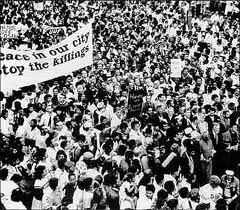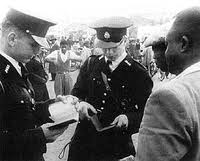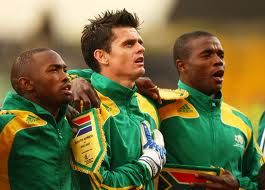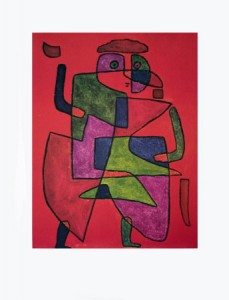Academic English I – Short Story Unit – Review Guide
“Father and I” (1923) by Par Lagerkvist
Subject Matter – childhood, coming of age, safety, security, trust in adults, knowledge, ignorance, fear, uncertainty, maturation process, the pangs of experience
Setting – Sweden, 1901 near the woods and a railroad yard
Point of View – 1st person narrative (young 10-year old Swedish boy)
Characters – 10-year old Swedish boy and his father, ghost conductor
Conflict(s) – fearful child vs. nature vs. the unknown + fearful child vs. complacent father,
Plot Details/ Symbolism/Dialogue – a walk in the woods, birds/trees/animals, railroad yard, train driver salute, Daddy’s home turf, daytime bliss, then it gets dark… nighttime creepiness, mysterious presences, ghost train, mysterious conductor; “We know there is a God, don’t we?” – “That was strange. What train was that I wonder. And I didn’t know the driver either.” – “That had been for me – for my sake. I guessed what it meant. It was all the fear that would come to me, all the unknown, all that Daddy didn’t know about and couldn’t save me from…”
Climax or Turning Point – A “ghost train” goes by and father doesn’t recognize the conductor.
Resolution/Denouement – After the boy’s father admits to being confused, the boy finally realizes that his Daddy won’t be able to give him all the answers he needs.
Possible Theme(s) – Life is full of darkness and mystery. Parents don’t know everything. No one else can live our lives for us. You can’t stay safe at home forever.
“The Storyteller” (1914) by Saki (H.H. Munro)
Subject Matter – train rides, unruly children, parenting/discipline, child-rearing, the problem of authority, restrictions on freedom, the art of story-telling, the meaning of goodness,
Setting – on a train near Templecombe, England, circa 1914
Point of View – 3rd person, limited omniscient
Characters – bachelor, aunt, Cyril, older niece, younger niece
Conflict(s) – prim and proper aunt vs. unruly children + bachelor vs. aunt
Plot Details/ Symbolism/Dialogue– train ride, cramped compartment, cows, sheep, grass in the field, aunt’s unenterprising story, bachelor’s beautiful story, pigs, flowers, clock, prince’s park, medals for goodness, myrtle bushes, wolf eats Bertha – “Not as pretty as any of you… but she was horribly good.” –“If I should not have been so extraordinarily good, I should have been safe in the town at this moment.”
Climax or Turning Point – Bertha (in the bachelor’s story) gets eaten by the wolf.
Resolution/Denouement – The bachelor exits the train compartment.
Possible Theme(s) – There’s more to goodness than simple obedience. We should teach children how to be self-sufficient, not passive and dependent. People love stories full of drama involving believable characters, not uneventful yarns about ‘perfect people.’
“The Masque of the Red Death” by Edgar Allan Poe
Subject Matter – plague, pestilence, health, wealth, opulence, snobbery, safety/security, protection, time, mortality, death
Setting – at a castellated abbey somewhere in Renaissance Italy, 1348
Point of View – 3rd person omniscient
Characters – Prince Prospero, guests and courtiers, the uninvited guest (avatar of the Red death)
Conflict(s) – rich, healthy people vs. the plague, Prince Prospero vs. uninvited guest
Plot Details/Symbolism/Dialogue – plague, prince’s castle, mask/masquerade party, costumes, phantasms, brightly-colored rooms (blue, purple, green, orange, white, orange, violet), black room with red windows + ominous clock, the uninvited guest dressed as a walking corpse with costume dabbled in blood, Prince Prospero exclaims: “Who dares insult us with this blasphemous mockery? Seize him and unmask him – that we may know whom we have to hang at sunrise from the battlements!”, Prince Prospero falls dead from the plague (lying prostrate on the ground) after having tried to kill his uninvited guest with a dagger.
Climax or Turning Point – Prince Prospero confronts the uninvited guest (the avatar of the Red Death) and then (minutes later) falls to the ground dead.
Resolution/Denouement – The Red Death holds dominion over all the other guests. No one is getting out of the abbey alive.
Possible Theme(s) – No one is totally safe. Everyone is vulnerable to the vicissitudes of life. The pursuit of safety above all else is dangerous and de-humanizing.
“Harrison Bergeron” (1961) by Kurt Vonnegut
Subject Matter – the future, equality, conformity, mediocrity, television, government regulation
Setting – somewhere in suburban America, circa the year 2081
Point of View- 3rd person omniscient
Characters – George and Hazel Bergeron, Harrison, ballerina, other dancers, musicians,, Diana Moon Glampers
Conflict(s) – Harrison Bergeron vs. Diana Moon Glampers, genius vs. champions of mediocrity
Plot Details/Symbolism/Dialogue – handicaps, head-set, loud noises, canvas bags, masks, television, announcers, dancers and musicians, “If I tried it….pretty soon we’d be right back to the dark ages again, with everybody competing against everybody else.” Harrison, the escaped fugitive. “I am the Emperor! Do you hear?”, “Play your best…and I’ll make you barons and dukes and earls.” Handicapper General Glampers executes Harrison and the ballerina Empress.
Climax or Turning Point – Harrison declares himself the new “Emperor” and chooses his Empress from among the ballerinas. Together they dance and “touch the ceiling” before being shot by the Handicapper General.
Resolution/Denouement – George and Hazel (as if numbed into submission) react somewhat indifferently to Harrison’s death on live television.
Possible Theme(s) – True equality is not the same as mindless conformity. Democracies should guard against mediocrity and middlebrow thinking. Individuality and excellence are threatened by a creeping “group-think” herd mentality.
“The Lottery” (1948) by Shirley Jackson
Subject Matter – small-town life, habit, custom, routine, worn out rituals and traditions
Setting – 1930’s/1940’s small town America
Point of View – 3rd person omniscient
Characters – Mr. Summers, Mr. Graves, Old Man Warner, Tessie Hutchinson, Mr. and Mrs. Adams, Mrs. Dunbar
Conflict(s) – Tessie Hutchinson vs. the other villagers, individual vs. worn-out tradition
Plot Details/Symbolism/Dialogue – June/summer, tractors, farm community, corn, harvest, annual gathering, lottery, black box, sheets of paper, rocks, ritual blood sacrifice (stoning to death), “Wouldn’t have me leave my dishes in the sink, now, would you, Joe?” – “Guess we better get started, get this thing over with, so’s we can get back to work.” – “We all took the same chance.” – “It isn’t fair, it isn’t right.”
Climax or Turning Point – Tessie Hutchinson “wins” the lottery.
Resolution/Denouement – The villagers stone Tessie Hutchinson to death – thereby fulfilling some kind of ancient human sacrifice ritual.
Possible Theme(s) – Blind allegiance to worn out traditions is dangerous. People can act like cattle when they fail to question what everyone else is doing. Every town needs a scapegoat.
“The Secret Lion” (1984) by Alberto Alvaro Rios
Subject Matter – adolescence, junior high school, “tweens “and their parents, exploration, discovery, knowledge , ignorance, change, growth and maturation
Setting – near Nogales, Arizona (1960’s or 1970’s )
Point of View – 1st person narrative (young unnamed narrator)
Characters – unnamed narrator, Sergio, mother, teachers, girls
Conflict(s) – young naïve boys vs. information-hoarding grown-ups, narrator vs. natural world
Plot Details/Symbolism/Dialogue – the lion, girls, bad words, arroyo, grinding ball/cannonball thing used in mining, burial of special, perfect objects, polluted waters, green “heaven”, golf course, picnics, “I was twelve and in junior high school and something happened that we didn’t have a name for, but it was there nonetheless like a lion and roaring, roaring that way the biggest things do. Everything changed. Just that.” “We had this perception about nature, that nature was imperfect and that round things are perfect.” – “Heaven was green, like nothing else in Arizona.” – “We buried it because it was perfect.” “We didn’t tell my mother, but together it was all we talked about, till we forgot. It was the lion.”
Climax or Turning Point: The narrator and his friend, Sergio, find “heaven” on a green grassy knoll only to learn that it’s only a golf course.
Resolution/Denouement – The boys return to the arroyo and try to play like they did before, but find that things aren’t the same. They’ve grown older.
Possible Theme(s) – Nothing stands still. All things must pass. You can’t step into the same river twice. It’s not the things themselves, it’s how we perceive them that counts.
“Once Upon a Time” (1992) by Nadine Gordimer
Subject Matter – fear, anxiety, crime, need for security, unstable society, unequal social relations/racism, fairy tales, fantasy, delusion, violence
Setting – 1970’s/1980’s South Africa
Point of View – 1st person narrative + 3rd person limited omniscient (a woman writer)
Characters – husband, wife, little boy, mean “old witch” (husband’s mother), housemaid, itinerant gardener, migrant workers, unemployed people (loafers and tsotsis)
Conflict(s) – family or insular neighborhood vs. outside world, tensions between rich and poor and between blacks and whites in South African society
Plot Details/Symbolism/Dialogue –children’s story anthology, house in the suburbs, woman murdered in broad daylight, Chopi and Tsonga migrant miners, local Neighborhood Watch, YOU HAVE BEEN WARNED sign, alarm system, iron bars, Space Man’s outfit, pet dog, prison architecture/ Spanish Villa style, razor-bladed coils, thicket of thorns, Dragon’s Teeth, prince’s palace and Sleeping Beauty – “and they were all living happily ever after…” – “When the man and wife and little boy took the pet dog for its walk round the neighborhood streets they no longer paused to admire this show of roses or that perfect lawn; these were hidden behind an array of different varieties of security fences.” – “Next day he pretended to be the Prince who braves the terrible thicket of thorns to enter the palace and kiss the Sleeping Beauty back to life.”
Climax or Turning Point: The boy hears a bedtime story and tries to act it out in real life.
Resolution/Denouement: The injured boy is carried into the house by the man, the wife, the trusted housekeeper and the weeping gardener.
Possible Theme(s) – You cannot hide from the world. The attempt to safeguard yourself from strangers may lead you to harm those closest to you. We are partially responsible for whatever is happening in the greater society, no matter how much we try to pretend otherwise. You may not be interested in war (or chaos), but the chaos is interested in you.











